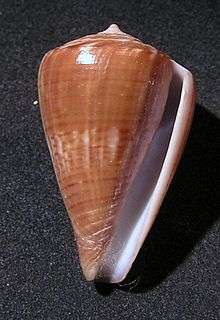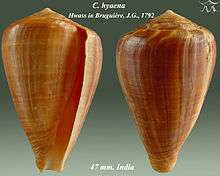Conus hyaena
Conus hyaena, common name the hyena cone, is a species of sea snail, a marine gastropod mollusk in the family Conidae, the cone snails and their allies.[2]
| Conus hyaena | |
|---|---|
 | |
| Conus hyaena | |
 | |
| Scientific classification | |
| Kingdom: | Animalia |
| Phylum: | Mollusca |
| Class: | Gastropoda |
| Clade: | Caenogastropoda |
| Clade: | Hypsogastropoda |
| Clade: | Neogastropoda |
| Superfamily: | Conoidea |
| Family: | Conidae |
| Genus: | Conus |
| Species: | C. hyaena |
| Binomial name | |
| Conus hyaena Hwass in Bruguière, 1792 [1] | |
| Synonyms[2] | |
| |

These snails are predatory and venomous. They are capable of "stinging" humans, therefore live ones should be handled carefully or not at all.
- Subspecies
- Conus hyaena concolor G. B. Sowerby II, 1841 (synonym: Conus concolor G. B. Sowerby II, 1841)
- Conus hyaena hyaena Hwass in Bruguière, 1792
Description
The size of an adult shell varies between 29 mm and 80.5 mm. The shell is somewhat swollen above. The spire is striate. The color of the shell is light yellowish brown, variegated by darker striations, and faint revolving lines or rows of spots, often indistinctly lighter-banded in the middle.[3]
Distribution
This species occurs in the Indian Ocean off Madagascar, in the Bay of Bengal, and in the Pacific Ocean off the Philippines and Indonesia; in the South China Sea.
References
- Bruguière, J. G., and Hwass, C. H., 1792. Cone. Encyclopédie Méthodique: Histoire Naturelle des Vers, 1: 586 -757
- Conus hyaena Hwass in Bruguière, 1792. Retrieved through: World Register of Marine Species on 25 July 2011.
- George Washington Tryon, Manual of Conchology vol. VI, p. 40; 1879 (described as Conus mutabilis)
- Dautzenberg, P. (1923). Liste préliminaire des mollusques marins de Madagascar et description de deux especes nouvelles. Journal de Conchyliologie 68: 21–74
- da Motta, A. J. 1983. Two new species for the genus Conus (Gastropoda: Conidae). Publicações Ocasionais da Sociedade Portuguesa de Malacologia 2:1–7, 13 figs.
- Filmer R.M. (2001). A Catalogue of Nomenclature and Taxonomy in the Living Conidae 1758 – 1998. Backhuys Publishers, Leiden. 388pp
- Tucker J.K. (2009). Recent cone species database. September 4, 2009 Edition
External links
- The Conus Biodiversity website
- "Rhizoconus hyaena hyaena". Gastropods.com. Retrieved 16 January 2019.
- Cone Shells – Knights of the Sea
| Wikimedia Commons has media related to Conus hyaena. |